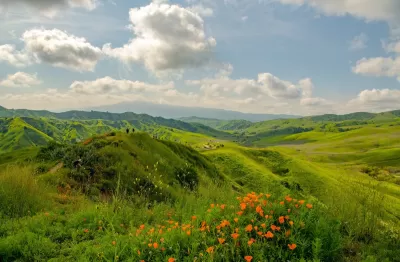A recently released report offers recommendations for keeping state parks healthy and robust, including acquiring additional land for conservation and recreation.

California's State Park System is the largest in the U.S. This system includes 279 separate park units on 1.4 million acres, with more than 280 miles of coastline, 625 miles of lake and river frontage, almost 15,000 campsites, and 3,000 miles of hiking, biking, and equestrian trails. However, these cherished spaces are now increasingly threatened by climate change. For example, ancient sequoia groves are burning in more frequent and severe wildfires, coastal parks are being eroded by rising sea levels and intensifying storms, and endangered species in state parks are losing vital habitat.
As reported by Tara Lynn Wagner, the California State Parks Foundation has just released a 70-page report entitled Building a Climate-Resilient California State Park System. It defines climate-resilient state parks as those which "can prepare for, adapt to, and recover from climate impacts." Specifically, this includes protecting natural and cultural resources, preserving park access, building climate-smart infrastructure, and educating Californians about parks and climate change. Climate-resilient parks also use clean energy and climate-smart land management to mitigate greenhouse gas emissions and contribute to statewide carbon neutrality.
The report offers the following recommendations:
- Rethink California State Parks’ representation in 30x30.
- Fund the full implementation of California State Parks’ Sea Level Rise Adaptation Strategy.
- Authorize and fund permanent climate resilience staff across relevant California State Parks divisions (or program areas or functions) for a multidisciplinary approach to building climate resilience into all aspects of park management.
- Expand California State Parks’ internal capacity to assess and scope adaptation projects.
- Extend funding for California State Parks’ Wildfire and Forest Resilience Program beyond its current expiration in FY 2027–28, including hiring authority for permanent staff positions.
- Establish a pilot program for California state parks as community climate resilience centers.
- Fund a robust California State Parks acquisition program.
For more information, please read the source article and the report.
FULL STORY: California State Parks face threat of climate change — but could also be part of the solution

Alabama: Trump Terminates Settlements for Black Communities Harmed By Raw Sewage
Trump deemed the landmark civil rights agreement “illegal DEI and environmental justice policy.”

Planetizen Federal Action Tracker
A weekly monitor of how Trump’s orders and actions are impacting planners and planning in America.

The 120 Year Old Tiny Home Villages That Sheltered San Francisco’s Earthquake Refugees
More than a century ago, San Francisco mobilized to house thousands of residents displaced by the 1906 earthquake. Could their strategy offer a model for the present?

San Francisco Opens Park on Former Great Highway
The Sunset Dunes park’s grand opening attracted both fans and detractors.

Oregon Legislature to Consider Transit Funding Laws
One proposal would increase the state’s payroll tax by .08% to fund transit agencies and expand service.

Housing Vouchers as a Key Piece of Houston’s Housing Strategy
The Houston Housing Authority supports 19,000 households through the housing voucher program.
Urban Design for Planners 1: Software Tools
This six-course series explores essential urban design concepts using open source software and equips planners with the tools they need to participate fully in the urban design process.
Planning for Universal Design
Learn the tools for implementing Universal Design in planning regulations.
Clanton & Associates, Inc.
Jessamine County Fiscal Court
Institute for Housing and Urban Development Studies (IHS)
City of Grandview
Harvard GSD Executive Education
Toledo-Lucas County Plan Commissions
Salt Lake City
NYU Wagner Graduate School of Public Service





























